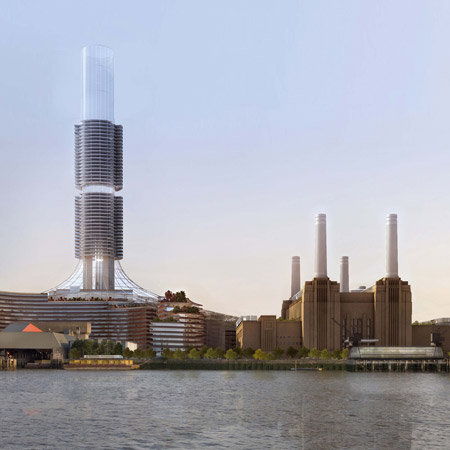
Battersea Power Station redevelopment by Rafael Viñoly Architects
Architect Rafael Viñoly has unveiled plans for the redevelopment of Battersea Power Station in London.

The proposal, for developer Treasury Holdings, includes a 300 metre high tower and an "Eco-Dome".

Here's some more info from the developer:
--
Battersea Power Station is reborn!
Real Estate Opportunities Limited (“REO”), a London listed property company, today launched its new vision and masterplan for Battersea Power Station.
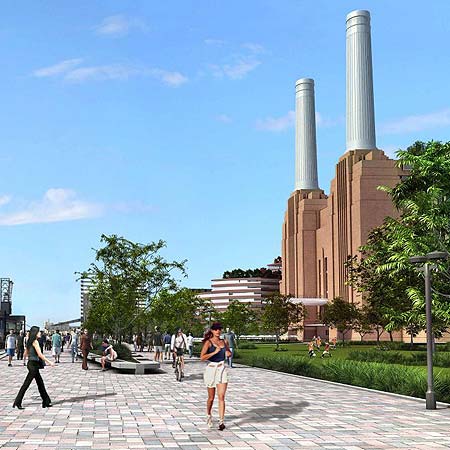
The iconic Battersea Power Station is to be brought back to life in the most advanced sustainable development ever to be built in this country. For the first time in a quarter of a century, Battersea Power Station will be used to generate electricity again but from renewable sources rather than coal.
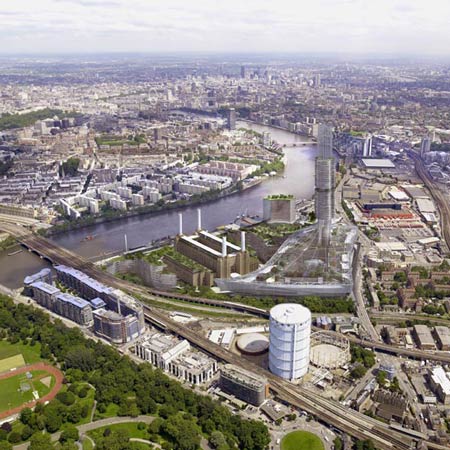
Rob Tincknell, Managing Director of REO’s development manager, Treasury Holdings UK, said: “We don’t embark on projects that we can’t deliver. We are determined that Londoners will not be disappointed and this area will be brought back to life in the most spectacular way. It will be a place to live, work and play.”
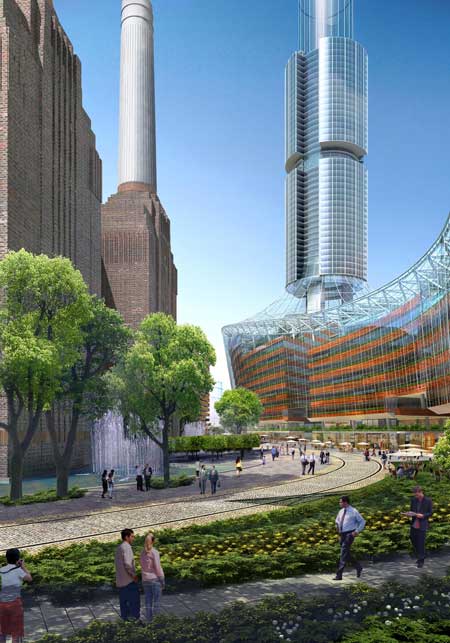
Alongside the existing power station there will be a new landmark, high quality building designed by the world-renowned architect Rafael Viñoly, which will be the cleanest and greenest building in London through innovative use of natural ventilation.
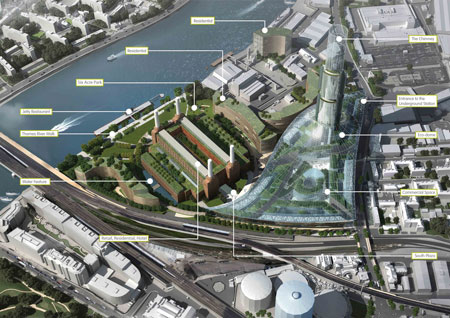
A spectacular 300 metre high Chimney and Eco-Dome will dramatically reduce carbon emissions of the 38 acre £4 billion development. The Chimney will also house apartments with panoramic views over London. The largest solar driven natural ventilation system ever conceived will eliminate the need for air conditioning for the commercial and ground floor retail accommodation.
The Chimney will draw air up through a campus of high quality individual office buildings which are covered by the light, transparent Eco-Dome, made of material similar to that used at the Eden Project. Up to 3,000 cubic metres per second of air will be drawn through the system on a sunny day, reducing energy demand in the buildings by 67%.
REO is planning to spend £150 million on saving and repairing Sir Giles Gilbert Scott’s 1930s power station, with the key historic spaces retained and open to the public. It will be developed to incorporate hotel, residential and retail accommodation. It will once again be used to produce power with a new combined cooling, heat and power plant, but this time using biofuels, waste and other renewable energy sources. Two of the existing power station’s chimneys will be reused as flues for this new Energy Centre.
The masterplan, unveiled today by Treasury Holdings UK on behalf of REO, will regenerate an area of London that will provide approximately 8 million square feet (750,000 square metres) of residential, office and retail space. There will be a six acre public park, a riverside walk and an urban square.
The Battersea Power Station development will be home to around 7,000 people and up to 20,000 new jobs will be created. More than 3,200 homes will be built on the site and 2,500 jobs will be created during the construction phase.
It is planned that construction work will start in 2012 and the development will be completed by 2020 – depending on the speed of the planning process.
The site is the single largest development site in central London and will act as a catalyst for the regeneration of the wider Nine Elms Corridor.
Treasury Holdings UK is in discussions with Transport for London and other landowners in the Nine Elms about building an extension of the Northern Line from Kennington to bring the Tube into the heart of Battersea.
The development has six key objectives:
The sensitive regeneration of Battersea Power Station
The creation of a zero carbon environment
The delivery of a sustainable mixed-use development which will ensure marketability and strong demand
To act as a catalyst for regeneration of the Nine Elms Corridor
To ensure that the project is totally deliverable
To facilitate a sustainable public transport solution
Rob Tincknell said:
“Climate change is the 21st century’s most urgent challenge and has not been adequately addressed by the development sector. At times like these we are required to open our minds and take a big leap.
“This will be a power station for the 21st century, sitting alongside Sir Giles Gilbert Scott’s building and supporting a truly sustainable, zero carbon development.
“We believe that we all have a responsibility to commit to true sustainability through groundbreaking innovation and we believe that our development will enhance London’s reputation as a leading global city.
“The preservation of Battersea Power Station alongside contemporary architecture will enhance its importance by juxtaposing old and new. Londoners have a strong emotional attachment to this building but most of all they want to see something positive happening on this site. We will meet and exceed their expectations.”
Rafael Viñoly said:
“Centered on the reconstruction of the remarkable architectural presence of the Power Station, the design introduces a fluid geometry for the new residential buildings that helps guide public access to the site and the waterfront. The open character of the vast industrial naves designed by Gilbert Scott is maintained and the chimneys are brought back into operation, utilized to exhaust water vapour produced by a new biofuel energy plant located in the basement.
“Offset from the volume of the Power Station, a near transparent shaft counterpoints the monumental mass of the building, providing a naturally ventilated office complex. A transparent envelope accommodating a distinctive public space, with access to a new underground station, connects to an adjacent residential component.
“The visual presence of this near transparent marker on the skyline defines a new opportunity area signalling London's commitment to innovation and sustainability.”